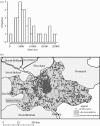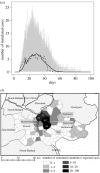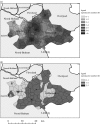Key strategies for reducing spread of avian influenza among commercial poultry holdings: lessons for transmission to humans
- PMID: 16959637
- PMCID: PMC1634894
- DOI: 10.1098/rspb.2006.3609
Key strategies for reducing spread of avian influenza among commercial poultry holdings: lessons for transmission to humans
Abstract
Recent avian flu epidemics (A/H5N1) in Southeast Asia and case reports from around the world have led to fears of a human pandemic. Control of these outbreaks in birds would probably lead to reduced transmission of the avian virus to humans. This study presents a mathematical model based on stochastic farm-to-farm transmission that incorporates flock size and spatial contacts to evaluate the impact of control strategies. Fit to data from the recent epidemic in the Netherlands, we evaluate the efficacy of control strategies and forecast avian influenza dynamics. Our results identify high-risk areas of spread by mapping of the farm level reproductive number. Results suggest that an immediate depopulation of infected flocks following an accurate and quick diagnosis would have a greater impact than simply depopulating surrounding flocks. Understanding the relative importance of different control measures is essential for response planning.
Figures





Similar articles
-
Avian influenza A virus (H7N7) epidemic in The Netherlands in 2003: course of the epidemic and effectiveness of control measures.J Infect Dis. 2004 Dec 15;190(12):2088-95. doi: 10.1086/425583. Epub 2004 Nov 15. J Infect Dis. 2004. PMID: 15551206
-
[Avian influenza: eradication from commercial poultry is still not in sight].Tijdschr Diergeneeskd. 2004 Dec 1;129(23):782-96. Tijdschr Diergeneeskd. 2004. PMID: 15624878 Review. Dutch.
-
The role of backyard poultry flocks in the epidemic of highly pathogenic avian influenza virus (H7N7) in the Netherlands in 2003.Prev Vet Med. 2009 Apr 1;88(4):247-54. doi: 10.1016/j.prevetmed.2008.10.007. Prev Vet Med. 2009. PMID: 19178969
-
Modelling H5N1 in Bangladesh across spatial scales: Model complexity and zoonotic transmission risk.Epidemics. 2017 Sep;20:37-55. doi: 10.1016/j.epidem.2017.02.007. Epub 2017 Feb 21. Epidemics. 2017. PMID: 28325494
-
Genesis of pandemic influenza.Cytogenet Genome Res. 2007;117(1-4):394-402. doi: 10.1159/000103203. Cytogenet Genome Res. 2007. PMID: 17675883 Review.
Cited by
-
Multi-agent modeling of the South Korean avian influenza epidemic.BMC Infect Dis. 2010 Aug 10;10:236. doi: 10.1186/1471-2334-10-236. BMC Infect Dis. 2010. PMID: 20696080 Free PMC article.
-
Risk maps for the spread of highly pathogenic avian influenza in poultry.PLoS Comput Biol. 2007 Apr 20;3(4):e71. doi: 10.1371/journal.pcbi.0030071. Epub 2007 Mar 5. PLoS Comput Biol. 2007. PMID: 17447838 Free PMC article.
-
Impact of the implementation of rest days in live bird markets on the dynamics of H5N1 highly pathogenic avian influenza.J R Soc Interface. 2011 Aug 7;8(61):1079-89. doi: 10.1098/rsif.2010.0510. Epub 2010 Dec 3. J R Soc Interface. 2011. PMID: 21131332 Free PMC article.
-
The effect of network mixing patterns on epidemic dynamics and the efficacy of disease contact tracing.J R Soc Interface. 2008 Jul 6;5(24):791-9. doi: 10.1098/rsif.2007.1272. J R Soc Interface. 2008. PMID: 18055417 Free PMC article.
-
[The impact of avian influenza on health care system].Zentralbl Arbeitsmed Arbeitsschutz Ergon. 2008;58(7):204-214. doi: 10.1007/BF03346219. Epub 2014 Mar 27. Zentralbl Arbeitsmed Arbeitsschutz Ergon. 2008. PMID: 32572306 Free PMC article. German.
References
-
- Alexander D.J. A review of avian influenza in different bird species. Vet. Microbiol. 2000;74:3–13. doi:10.1016/S0378-1135(00)00160-7 - DOI - PubMed
-
- Anderson R.M, May R.M. Oxford University Press; New York, NY: 1991. Infectious diseases of humans: dynamics and control.
-
- Beare A.S, Webster R.G. Replication of avian influenza viruses in humans. Arch. Virol. 1991;119:37–42. doi:10.1007/BF01314321 - DOI - PubMed
-
- Blower S.M, Dowlatabadi H. Sensitivity and uncertainty analysis of complex models of disease transmission: an HIV model, as an example. Int. Stat. Rev. 1994;62:229–243.
-
- Capua I, Marangon S. Vaccination for avian influenza in Asia. Vaccine. 2004;22:4137–4138. doi:10.1016/j.vaccine.2004.04.017 - DOI - PubMed
Publication types
MeSH terms
LinkOut - more resources
Full Text Sources
Medical

